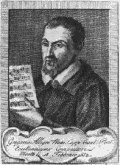
Gregorio Allegri
Gregorio Allegri is one of music's great one-work-wonders. He is famous today (and throughout history) for just a single, magnificent composition, his Renaissance masterpiece
Miserere mei Deus for nine part choir.
The
Miserere is a work wrapped in legend and shrouded in mystery, and yet its origins are very plain, it being a setting of Psalm 51.
Miserere mei, Deus, secundum magnam misercordiam tuam.
Have mercy upon me, O God, after thy great goodness.
Settings of Psalm 51 have been performed for Easter as far back as 1514, but since Allegri wrote his version around 1638, it is his that has been performed every year since then.
Somebody powerful in the Vatican took a special liking to Allegri's
Miserere soon after it was written and decreed that it was not to be copied or removed from the Vatican on pain of excommunication. In effect, the Church banned its performance anywhere in the world except within the Sistine Chapel.

Sistine Chapel
And its not hard to see why. It is a musical personification of the Renaissance view of God - overpoweringly beautiful and yet stunningly simple at once, unlike anything written before. An arching melody flows forth carried by angelic sopranos (sung at the time by
castrati), and climaxing with a solitary voice holding a haunting, impossibly high top C. Heaven itself revealed.
Despite (or perhaps because of) the Papal ban on its copying and performance, its fame spread throughout Europe. Visitors to the Vatican at Easter would make a point of experiencing this heavenly work.

Wolfgang and Leopold Mozart
One such visitor was a twelve year old Wolfgang Amadeus Mozart on a 15 month tour of Italy with his father, Leopold. They arrived in Rome just in time for Easter, 1770. The Mozarts heard the famous work performed at the Sistine Chapel on Easter Wednesday, and legend has it that on returning home, Mozart junior sat down and wrote out the entire piece from memory. With a second hearing on Good Friday, manuscript hidden under his hat, the young Amadeus was able to make a few minor corrections.
But the Mozarts were responsible enough not to circulate it. Leopold wrote to his wife that Wolfgang had indeed transcribed the famous music, but as it was a secret of Rome, they did not wish to let it get into the hands of others. But just a year later, the
Miserere was published in London, forever breaking the Papal monopoly. Through what hole in the net had it escaped?
The plot thickens. While the Mozarts were completing their tour of Italy, an English music historian by the name of Dr Charles Burney, was also in Rome. His special interest was the music for the celebration of Easter in the Sistine Chapel, and it was this Burney that was the publisher of Allegri's
Miserere. How did he come across it?
In his studies in Bologna, Burney met Giovanni Battista Martini, famous composer and known to have a copy of Allegri's manuscript. He also consulted the Choirmaster Santarelli at the Vatican. But given the Papal decree, it is unlikely that either of these men would divulge the music to a foreigner.
The really interesting thing is that in Bologna Burney also met Mozart, there to study with the Padre Martini. Did Mozart, perhaps showing off, give Burney a copy of the manuscript, and thereby unwittingly reveal it to the world? Possibly.
However, Burney's version is plain and unembellished, probably how Allegri had originally written it. Mozart would have transcribed the performed version, with all its secret ornamentation, the so called
abbellimenti, embellishments never written down, but passed on from singer to singer in the choir.
We may never know as Mozart's transcription has since been lost. But fortunately we still have the
Miserere in all its splendor.

Tallis Scholars
The performance here by the Tallis Scholars glows. They recreate the Chapel setting with different parts of the choir positioned throughout the church creating daring stereophonic effects. Their powerful sound comes from just 21 singers.
The CD also includes two other works; Palestrina's magnificent
Missa Papae Marcelli, another Renaissance standard and the work that is said to have convinced the Church to lift its ban on polyphony, and
Vox Patris Caelestis by William Mundy. This work, almost unknown, is an experiment of early mysticism and complex counterpoint exuding spiritual calm and beauty.
If you have never heard this music before, you will wonder how music so beautiful could have passed you by. And if you are familiar with Allegri and company, this masterful performance will not disappoint. Heaven on a disc.
Please support Good-Music-Guide.com
by purchasing this CD using this link.

Track Listing
Allegri - Miserere
The Tallis Scholars
- Allegri - Miserere
- Mundy - Vox Patris Caelestis
Palestrina - Missa Papae Marcelli
- Kyrie
- Gloria
- Credo
- Sanctus & Benedictus
- Agnus Dei I & II